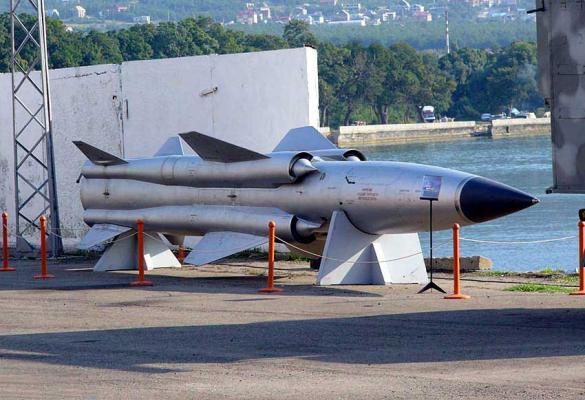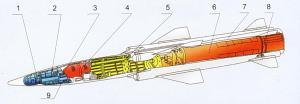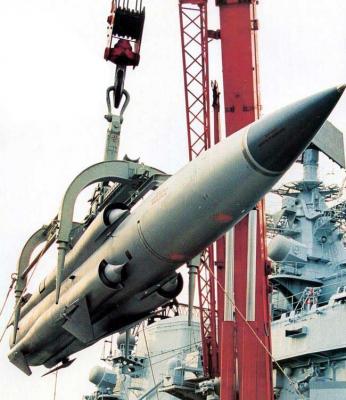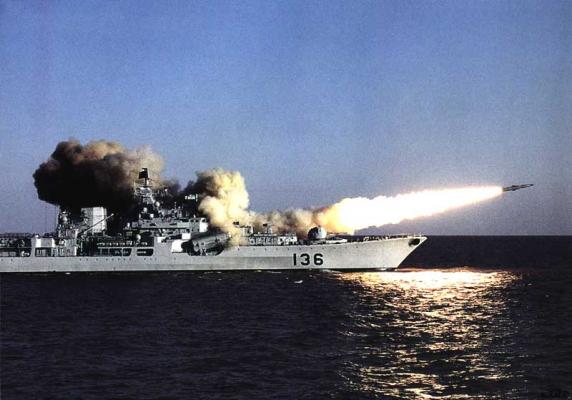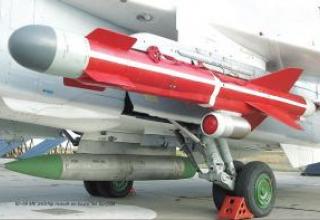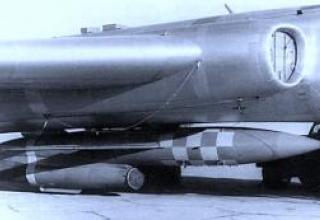Winged missile 3M-80 is part of the missile systems, which are designed to destroy surface ships and vehicles from the ship's strike groups, landing units and convoys, as a displacement and hydrofoils and air cushion, with a speed of up to 100 knots, in the conditions of fire and electronic counteraction of the enemy, in any environmental conditions, under the influence of the damaging factors of nuclear explosion.
The development of the Moskit ZM-80 SCR began in 1973 in the Rainbow Design Bureau (Dubna) under the supervision of Chief Designer I.S. Seleznev. Onboard and ship control systems were developed in the State Scientific Production Association "Altair" (Moscow) under the guidance of Chief Designer S.A. Klimov. Design of the rocket direct-flow air jet engine was started at Design Bureau-670 (Moscow) under the supervision of Chief Designer M.M.Bondaryuk, and completed at ICB "Soyuz" (Turaev, Moscow region), Chief Designer V.G.Stepanov. Starter motors were created in Design Bureau-2 of Plant No.81 of the Ministry of Aviation Industry (Moscow), Chief Designer I.I.Kartukov. The launcher was developed at the Machine Building Design Bureau (Moscow), Chief Designer N.K. Tsikunov. Series production of ZM-80 missiles was carried out in PA "Progress" in Arsenyev, Primorsky Krai.
In the early 80's the anti-ship system 3M-80 "Moskit" was adopted for service of destroyers (EM) type "Modern" project 956. These ships were equipped with two quadruple KT-190 launchers. The first destroyer of the project 956 "Modern" (plant № 861) was laid at the plant named after M.V. Lomonosov. Zhdanov (now "Northern Shipyard") in Leningrad on March 3, 1976, was launched on November 18, 1978, and on January 24, 1981 was included in the Northern Fleet. The second destroyer "Desperate" was laid down on March 4, 1977, launched on March 29, 1980 and joined the Northern Fleet on November 24, 1982. Totally till the end of 1993 17 ships of project 956 were built at "Northern Shipyard" and several more remained unfinished due to the collapse of the USSR. Two of the unfinished destroyers of project 956 - "Vazhny" and "Vdumchivy" (renamed into "Yekaterinburg" and "Alexander Nevsky") were sold to China together with "Moskit" complex due to lack of financing.
Besides project 956 EM and project 11556 BOD "Admiral Lobov", the Moskit missiles received project 1241.1 boats (see photo). The first missile boat of project 1241.1, designed by the Central Design Bureau "Almaz", with two dual-container launchers KT-152M of Moskit complex was delivered in 1981. Then more than 20 such boats were built at PA "Almaz", Sredne-Nevsk and Khabarovsk plants.
Rockets "Moskit" were armed with unique small missile ships pr.1239 on a hovercraft. The Ave. 1239 has a hull made of aluminum-magnesium alloy with full displacement of 1050 tons. The power plant is combined, consisting of two gas turbines with capacity of 20 thousand hp each, two diesel engines with capacity of 10 thousand hp each and two diesel engines with capacity of 3300 hp. Under the gas turbine engines the cruise speed reaches 50 knots, and under the diesel engines the ship goes at a speed of 12 knots. The ship has two quadruple "Moskit" launchers, one "Osa-M" SAM system, one 76 mm AK-176 and two 30 mm AK-630M. The main ship "Bora" was built in Zelenodolsk in 1987 and accepted for trial operation on December 30, 1989. The second ship of this type was built there in 1991-1992. (see photo)
On the pilot small missile ship MRK-5 project 1240 (hydrofoil) installed two paired PU. In addition, "Moskit" was installed on the screen plan "Lun".
In maritime aviation, the Su-27K(Su-33) and Su-32FN can be fitted with one 3M80 missile under the fuselage between nacelles (see photo).
On 4 January 1981, Resolution No 17-5 of the Council of Ministers on the upgrading of the Moskit complex was issued. The condition of the modernization was to increase the range of fire. For this purpose the marching engine was modernized, it started working on a new more energy-intensive type of kerosene and received a new nozzle with an adjustable critical section. During the tests 10 upgraded Moskit-M missiles were launched. The first launch took place on August 6, 1987, and the last one on July 7, 1989. The launches were carried out from the 1241.1 project boat. The range during the launches was unstable, with a maximum of 153 km. The modified missile with extended range has the designation 3M-80E.
As a result of further modernization, the Moskit-MBE complex was created with the 3M-80ME anti-ship missile with a significantly increased range. The Moskit-MBE complex can be exported as part of the 956EM squadron of destroyers, 12421 missile boats and other projects of ships built by enterprises of the Russian Federation, as well as independently for placement on foreign customer carriers, providing conditions of operation and combat use of the complex. The Moskit-MBE complex may also be adapted for use as part of a fixed or mobile shore position of a foreign customer to protect its maritime borders.
In the west 3M80 was designated SS-N-22 "Sunburn" (ASM-MSS).
Composition:
The ship complex P-270 is a part of the ship complex:
- 3M-80 cruise missile
- Container-type launcher KT-152M (non-container-type), which serves for long (up to 18 months) storage of missiles on board the ship and ensure the launch of missiles on command with the SSAS, as well as their accidental release in extreme situations photo);
- the ship's 3C-80 control system, which provides verification and preparation of the missiles for launch, processing of data received from the means of designation (simultaneously for four targets), their entry into the guidance system of the missiles, the distribution of missiles to targets, launch - single and multiple launch - until the full use of the ammunition;
- a loading device (SU) designed to load missiles into the PU and unload them (see Photo 1, Photo 2, Photo 3, Photo 4);
- KNO 3F80 ground equipment complex designed for operation of missiles under conditions of technical position. The CCW provides transportation, storage of missiles in arsenals and warehouses, their routine maintenance, verification and preparation for delivery to the ship.
Anti-ship supersonic cruise missile 3M-80 "Moskit" is built according to the normal aerodynamic scheme (see the scheme, layout scheme PKR 3M-8MVE). Fuselage - the body of rotation with an ogival shape of the bow and the X-shaped arrangement of the wing and plumage. Wing and plumage folding, made of titanium OT4 and OT4-1, spars - from steel ON-3. The body has four side air intakes and ducts. Front fairing with radio-transparent coca (three-layer fairing made of SCAN-E glass fabric on K-9-70 binding material). The lining and the intermediate set are made of VT-5, the tank compartment is made of stainless steel, spars are made of VKL-3, gargots are made of T-10 glass fabric on K-9-70 binder. Air ducts of a welded design - from titanium ОТ4-1, ОТ4.
The engine unit is combined, consists of a direct-flow air jet engine ZD83 and a starting powder accelerator. And the starter is inserted into the nozzle of the marching engine. After 3-4 seconds after starting, the powder engine burns down and is pushed out of the nozzle by the raging air flow.
The combined control system consisting of an inertial navigation system and an active-passive homing radar head provides a high probability of hitting the target even under conditions of radio counteraction by the enemy. For a group of boats or a ship's strike group, the probability is 0.99; for convoys and landing units, the probability is 0.94.
After launch, the missile makes a "slide" and then drops to a flight height of about 10-20 meters, when approaching the target there is a decrease to 7 meters above the crest of the waves (see diagram). The missile can perform intensive anti-aircraft manoeuvres with overloads exceeding 10g, which end 9 km before the target. Due to the huge kinetic energy "Mosquito" penetrates the hull of any ship and explodes inside. Such a blow can sink not only a middle-class ship, but also a cruiser. And 15-17 Mosquitos are a whole ship group.
The time of readiness of the ship-based complex to fire from the moment of power supply to the missiles to the start of the first missile 50c, from the state of high readiness 11c. Firing interval during salvo launch of the missiles - 5c.
Characteristics:
| Range of fire maximum, km: - 3M80 - start from a surface ship (SC). - 3M80 - start with the plane - 3M80E - start with NC - 3M80MWE - low altitude start with NC - 3M80MWE - start with NC by combined trajectory |
90 250 120 140 240 |
| Speed of flight: - maximum - cruiser |
2.8М 2.35М |
| Range of fire is minimal, km | 10-12 |
| Carrier speed, m/sec | 200-470 |
| Launch height, km | up to 12 |
| Post-start reversal | +/- 60° |
| The dimensions of the rocket, mm: - length 3M80, 3M80E - length 3M80MWE - maximum housing diameter - wingspan (folded/unfolded) |
9385 9745 760 1300/2100 |
| Conditions of combat use: - ambient air temperature - sea disturbance - wind speed (any direction) at sea level |
between -25 and +50°C up to 6 points (up to 5 for small targets). up to 20 m/s |
| Shelf life on a medium, years. | 1.5 |
| Launch mass of the rocket, kg: - 3М80 - 3М80E - 3М80E1 - 3М80МВE |
3950 4150 3970 4450 |
| Weight of combat unit, kg | 300-320 |
| Weight of combat unit Air Force, kg | 150 |
| Marshal engine | |
| Developer | ICB "Soyuz" (Turaevo) |
| Type | RVRP 3D83 |
| Launch speed, M. | 1.8-2.5 |
| Launch time, s | 0.5 |
| Working time, s | 250 |
Testing:
Tests of "Moskit" complex started in June 1978 at "Sandy Beam" range. The flight and design tests began with two throw launches on June 9 and October 10, 1978. The mock-up of the rocket was equipped only with the starting engine. Both launches were normal. Then came a long break, mainly due to the unpreparedness of the material part of the rocket, in particular, the marching engine, which was difficult to be brought to the manufacturer.
On December 29, 1979 a model equipped with a marching engine was launched. The launch was unsuccessful, as the marching engine was not launched, and the starter remained in the nozzle block of the marching engine after development. After the start, a timeout was taken again to rework the marshal engine. The next launch took place only on July 3, 1980. The task of the launch was to get a reliable start of the rocket and make a flight at an altitude of about 20m. The launch was considered to be successful, but the marching engine never reached the design mode.
January 27, 1981 the rocket "Moskit" for the first time was launched in full configuration, but without turning on the active channel combined CNS. The rocket was to hit the target SM Pr.1784 at a distance of 38 km. The launch was unsuccessful due to instability of the onboard control system. At launch on April 28, 1981 a task similar to the previous launch was set. Direct hit to the target was achieved. On June 2 there was shooting at two targets - SM pr. On June 2 there was firing at two targets - SM Pr. 1784 and BKShP No. 436 bis at the distance of 38 km without switching on the active channel of combined GSN. The launch was successful and a direct hit to a larger target, SM, 1784 Pr. was achieved.
By the beginning of June 1981 a new modernized target SM Pr.1784 arrived to provide flight tests of ZM-80 missiles. 1784M Prospect, manufactured in Nikolaev. On this target, as well as on the old SM Ave. The whole system of radar reflectors in the amount of about 50 pieces of different types (K-0.7, K-1.25, etc.) and a thermal imitator "Balancer" working on household gas propane-butane were left on this target, only instead of one burner there were two (it was believed that a big ship - a battleship, a cruiser or an aircraft carrier - had at least two radiation centers). The target of the CM Ave. At the SM target of 1784M Ave. the system of external trajectory measurements was fundamentally improved. Previously, the film camera and photo equipment, shooting the missile approach to the target, were installed "on the eye", and now the film camera was tied to the target itself with a high degree of accuracy. The camera viewing angles were chosen so that they necessarily included some element of the target structure in addition to the missile. In order to test the operation of the active channel of the combined RS on a ZM-80 missile on the SM target, the cameras were designed to be able to detect the target. 1784M was equipped with a special system called "Minaret". The system included "Don" radar with a modified antenna system, remote control system for television signaling and telecommunications, equipment for documentation of operating modes, etc. In addition, two "Puck" and "Rynda" systems were installed, which determined the missile miss rate. The "Puck" system determined the magnitude of the miss relative to its antenna, and the "Rynda" system determined the magnitude of the miss relative to the so-called "reduced target". The target also had a well-equipped cockpit to accommodate the team. On June 26, 1981, two targets were fired - SM Pr.1784M, set from the starting point at a distance of 40 km, and on the BKShchina Pr.436 bis, set from the starting point at a distance of 10 km. The missiles were launched with active and passive CNS channels connected. The launch was considered successful. The missile hit the SM target at 436bis Ave. 1784M (pierced the target grid at 1.0m from the deck) and was driven 80km from the launch point. This launch ended the program of flight and design testing of the Moskit complex.
Launches under the program of joint (state) testing began in August 1981. At this stage of testing, the missiles were launched both from the coastal launcher and from a large missile boat of project 1241.1 (plant № 402) and destroyers of project 956 "Modern" (plant № 861) and "Desperate" (plant № 862). The first launch under the joint testing program took place on August 21 from the coastal launcher on target SM of 1784M pr.1784M to the range of 102 km. The task of the launch was to check the operation of all units and assemblies. Direct hit to the target was achieved. On September 30 it was launched from the boat of project 1241.1. The model of the rocket was equipped only with a starting engine. The mock-up was launched normally from the boat, which ran at a speed of 24 knots. when the sea waves 2-3 points. After that, the boat with the factory number. 402 was allowed to participate in joint testing of the Moskit complex.
On October 2, 1981 the launch was made with the task similar to the launch on August 21, but this time the target was not exposed. The launch was considered successful.
On November 24th the boat of project 1241.1 was launched from the target of SM Pr. On November 24th it was launched from the boat of the project 1241.1 on the SM target of 1784M pr. for the range of 100 km. The launch ended in failure due to a malfunction in the onboard control system. The rocket fell into the sea on the 10th second after the launch.
On December 27, 205 and 305 missiles were fired in volley from the boat of 1241.1 Ave. at two targets - BKShchinskaya Ave. 436 bis and SM pr. 1784М. The distance to the target of the BKSh was 10 km. Missile No 205 was aimed at this target. The launch was considered successful - a direct hit to the target was achieved. The range to the SM target was 33km. Missile No. 305 was to be aimed at this target. The launch was unsuccessful - the covers of the air intakes of the marching engine did not open, and the missile was brought to 23.7 seconds of flight. The interval between launches was 5 seconds.
On April 14, 1982 the missile was launched from the shore-based installation on the target of the SM Ave. 1784M Ave. at a distance of 100 km. The launch was unsuccessful. The missile fell at the 24th km distance due to malfunctions in the onboard control system.
On April 29, the first launch from the destroyer of the project 956 "Modern" in the Northern Fleet on the target of OS-111 (trawler project 265K) at a distance of 141 km was made. The launch was successful - a direct hit to the target superstructure was achieved. May 26, 1982 volley firing of rockets № 106 and № 505 from the destroyer "Modern" on the target of OS-111 at a distance of 35.5 4 m was carried out. Both missiles with equipment for the combat unit TC-22 were simultaneously launched from both sides of the destroyer. Rocket number 505 hit the target, hitting its superstructure. Rocket number 106 did not lower the flight height in front of the target, flew over it at an altitude of 17 m from the waterline and flew 47.5 km. The shooting was found to be partially successful. But the rocket number 106 could have flown not 17 m above the waterline, but 170 m, still with the presence of TC-22 ship would not have seemed a little Yankee.
On August 31, 1982, it was launched from the boat of project 1241.1 at a distance of 100 km with a 50-target position after the launch from two targets of OS-111 and SM pr. 1784М. The launch was unsuccessful - the marching engine was not launched and the missile fell into the sea at a distance of 12.8 km from the boat.
September 15 was a repeat of the previous launch. On September 15, it was a repeat of the previous launch. 1784M Ave. and hit it. The actual range of fire was 107.7 km.
On September 29 the boat of project 1241.1 was launched from the boat to the range of 27 km at the target of OS-1.11. A direct hit was achieved, the target sank.
November 28, volley firing of rockets ¹ 306 and ¹ 506 was made from the destroyer of project 956 "Desperate" in the Barents Sea in the Northern Fleet. (Shots were fired in parallel with the ship's delivery tests.) The target range of the target was set at the SM Ave. 1784 was 27 km. The speed of the ship during the launch was 20 knots. Firing was carried out from the starboard launcher, the interval between launches was 5 seconds. The target was hit by both missiles.
This was the end of the joint testing of the Moskit complex. In the course of these tests conducted 15 launches (14 missiles and 1 mock missile). According to the decision of the State Testing Commission, there were 8 fully successful launches, 5 partially successful launches and 2 unsuccessful ones.
In the period from 1983 to 1988, there were three types of tests of the Moskit complex. Firstly, tests on improvement of tactical and technical characteristics, ZM-80 missiles were conducted. In total, there were three launches: March 11, 1983, June 29, 1983. (mock missile) and December 7, 1984. At this stage, the flight range of 125 km was achieved.
Since the early 1980s, the possibility of installing the Moskit complex on the Lunar screen of Project 963 was considered. For this purpose, a mock-up of the screen plan of project 903 was installed at the "Sandy Beam" range in the village of Chernomorsk. The main purpose of the tests was to check the ability of the screen plan design to withstand the force and heat of the starting engine jet. On October 5 and December 21, 1984 two launches of "Moskita" mock-ups equipped only with starting engines were held. The first launch was made from the right container of the bow pair of launchers, and the second launch - from the left container of the tail pair of launchers. Since there were only two containers, the nose pair stood in its place at the first start and then it was moved to the tail. During these tests were tested two options for loading missiles on the screen, the first version of the rocket was loaded into a container already installed on the screen, using the loading device, the second version of the rocket was loaded into a container located on the ground, and then the entire structure was installed on the screen. All launches went smoothly. After the first launch 9 tiles were damaged, after the second one - 2. There were two launches of ZM-80 missiles in the Caspian Sea. The target was the BKShchy Ave. 436bis. The first launch was unsuccessful due to crew errors. During the second launch there was a double salvo (at an interval of 5 seconds). The launch was counted as successful.
Sources:
- А.В.Карпенко, С.М. Ганин "Отечественные авиационные тактические ракеты", "Бастион" N1, 2000г.
- Противокорабельный ракетный комплекс М3-80 "Москит" Широкорад А. Огненный меч Российского флота - М.:Изд-во Яуза, Изд-во Эксмо, 2004
- «Энциклопедия Отечественного ракетного оружия». А.Б.Широкорад. Под общей редакцией А.Е.Тараса-М.: АСТ, «Харвест», 2003 г.
- Корабельный комплекс ракетного оружия «Москит-МВЕ» с противокорабельной ракетой 3М-80МВЕ
- Противокорабельный комплекс ракетного оружия «Москит - Е»
